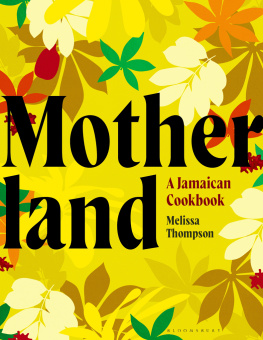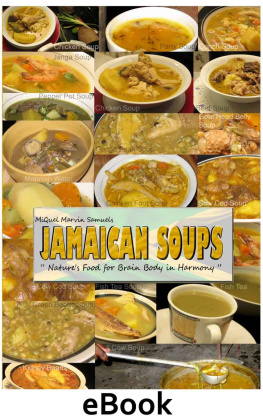
Ackee is an ornamental tree from West Africa that bears a bright red fruit. When ripe it bursts open to reveal three large black seeds and a bright yellow flesh that is popular as a breakfast food throughout Jamaica. Ackee is poisonous if eaten before it is fully mature, and because of its toxicity, is subject to import restrictions and may be hard to obtain in some countries. Never open an ackee pod; it will open itself when it ceases to be toxic. Ackee is sold canned in West Indian markets.

Allspice berries are grown primarily in Jamaica. They are a whole spice tasting of nutmeg, cinnamon, black pepper and clove. Used in numerous Jamaican dishes such as Jerk Pork, ground allspice is sold in most supermarkets. Just to make things interesting, Jamaicans refer to allspice as pimento.

Annatto is a reddish-yellow seed from a flowering tree native to the West Indies and Central America. Islanders store their annatto seeds in oillending the oil a beautiful reddish color. Saffron, turmeric or red food coloring may be substituted.

Breadfruit is a large tree fruit with a pebbly green skin and potato-like flesh. It is edible when cooked and can be used in place of any starchy vegetable, rice or pasta. Breadfruit is picked before it ripens and is typically served baked, grilled, fried, boiled or roasted. Its even been known to turn up in preserves or in beverages. Substitute potato or sweet potato if unavailable.

Callaloo is what the Jamaicans call the large edible green leaves of the taro root, usually prepared as one would prepare turnip greens or collard greens. Spinach is a good substitute.

Cassava is a large root vegetable also known as tapioca, manioc or yuca. It has a tough brown skin and very firm, nutritious white flesh. Ground cassava, used for cakes, is sold in packets in West Indian markets.

Cho-cho is a pear-shaped, light green squash with a mild flavor. It is known elsewhere as chayote. To preparepeel, halve and remove the seed before slicing and cooking the flesh. Zucchini or summer squash make good substitutes.
Conch or sea snails, are a beloved part of Caribbean cuisine. Conch meat must be pounded or ground in a food processor, to make it tender. Substitute any firm, white fish.

Coconut is edible in both its young and mature forms. Both the water and the jelly of the green coconut find their way into island drinks, and meat from the mature coconut gives many desserts a Caribbean identity. Coconut cream and milk are now widely sold canned and in packets which are quick and convenient. They come in varying consistencies depending on the brand, and you will need to try them out and adjust the thickness by adding water as needed.
Goat meat is eaten with enthusiasm in only a few places in the world, and Jamaica is assuredly one of them. Some credit immigrants from India who searched in vain for mutton to prepare their beloved curry. Finding no lambs, they latched onto the next best thingand curried goat became a Caribbean classic. Most first-timers find goat milder in flavor than lamb and an excellent substitute for lamb in most recipes. Of course, if you cant find goat, you can substitute lamb.

Guavas are small fruits with green or pink, seed-filled flesh. Guavas grow all over Jamaica and the fruit lends itself well to juices, jellies, preserves, fruit cups, sauces, cocktails and desserts. When green, guavas are slightly tart; when ripe, they are sweeter.

Kale, sometimes referred to as Chinese broccoli, is enjoyed for its firm texture and emphatic flavor. This leafy green vegetable is recognizable by the thick central stem and dull, thick leaves with a bluish tinge. Only the tender portions of the stems and young inner leaves are generally eaten as the outer leaves are quite bitter. The thicker stems are peeled and halved lengthwise before cooking. Substitute broccoli stems.

Nutmegs, Jamaican cooks insist, should be bought whole and grated only as needed. The spicy-sweet flavor of this aromatic fruit seed makes it an excellent addition to cakes, puddings and drinks.

Otaheiti apples are yet another fruit introduced from the Pacific by Captain Blighthe pear-shaped otaheiti apple ranges from pink to ruby red in color and is usually eaten fresh, though it can be poached in red wine or turned into a refreshing cold drink. Substitute pears if unavailable.

Papaya, a native of South America, is still called by its Amerindian name of pawpaw by some Jamaicans. The papaya has an orange color when ripe, and its mild flavor resembles that of a summer squash, making it a nice complement to the sharper flavors of other fruits. Green papaya is often used as an ingredient in chutney or relishes and makes a nice main dish when stuffed. When ripe, it is eaten as a melon, or served in fruit salad. Papaya juice makes a refreshing drink when sweetened with condensed milk or sugar. Pickapeppa sauce (see photo on page 71) is a commercially bottled sauce that is a key ingredient in Jamaican cuisine. The sweet, sour and spicy mixture was developed by Jamaican Norman Nash in the early 1920s. It contains a combination of tomatoes, onions, cane vinegar, mango, raisins, tamarind, chilies, and secret spices that is aged in oak for one year. Pickapeppa is sold in well-stocked supermarkets and spice shops. If you cannot find it, use steak sauce instead.

Plantains, sometimes referred to as cooking bananas, are a starchy vegetable that look like bananas on steroids. A green (unripe) plantain will first turn yellow and then black if allowed to ripen at room temperature. As it ripens, the pulp becomes sweeter and less starchy, but never as a sweet as a banana. Plantains are increasingly found in well-stocked supermarkets. Substitute unripe bananas or sweet potatoes.

























